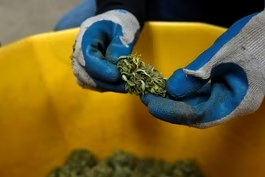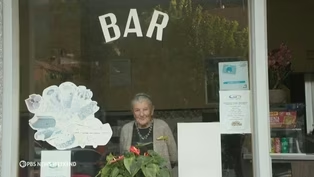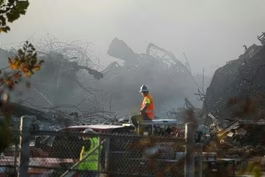
Takeaways from COP30 halfway through the UN climate summit
Clip: 11/16/2025 | 5m 45sVideo has Closed Captions
Key takeaways from COP30 halfway through the UN climate summit
This weekend is the halfway point for the 30th U.N. climate summit known as COP30. In a report issued days before the meeting began, the World Meteorological Organization said 2025 is “on track to be among the three warmest years on record.” New York Times international climate reporter Somini Sengupta, who just returned from COP30, joins John Yang to discuss.
Problems playing video? | Closed Captioning Feedback
Problems playing video? | Closed Captioning Feedback
Major corporate funding for the PBS News Hour is provided by BDO, BNSF, Consumer Cellular, American Cruise Lines, and Raymond James. Funding for the PBS NewsHour Weekend is provided by...

Takeaways from COP30 halfway through the UN climate summit
Clip: 11/16/2025 | 5m 45sVideo has Closed Captions
This weekend is the halfway point for the 30th U.N. climate summit known as COP30. In a report issued days before the meeting began, the World Meteorological Organization said 2025 is “on track to be among the three warmest years on record.” New York Times international climate reporter Somini Sengupta, who just returned from COP30, joins John Yang to discuss.
Problems playing video? | Closed Captioning Feedback
How to Watch PBS News Hour
PBS News Hour is available to stream on pbs.org and the free PBS App, available on iPhone, Apple TV, Android TV, Android smartphones, Amazon Fire TV, Amazon Fire Tablet, Roku, Samsung Smart TV, and Vizio.
Providing Support for PBS.org
Learn Moreabout PBS online sponsorshipThis weekend is the halfway point for the 30th annual U.N.
Climate Summit, known as COP30.
Delegates from nearly 200 countries are meeting in Belem, Brazil, on the edge of the Amazon rainforest, which is the world's largest.
In a report issued just days before the meeting began, the UN's World Meteorological Organization said 2025 is on track to be among the three warmest years on record.
It said the planet's average temperature in the first eight months of the year was nearing the limit for warming set 10 years ago in the landmark Paris Climate Accords.
New York Times international climate reporter Somini Sengupta has just returned from COP 30.
Somini, one former U.N.
climate chief, was quoted as saying that asking what agreement is going to come out of this meeting is the wrong question.
So what is the goal?
What are they trying to do at this time?
SOMINI SENGUPTA, The New York Times: I think primarily they're trying to keep the idea of international climate cooperation alive.
But also the delegates who are meeting in Belem have a couple of things that they want to get done.
They want to see to what extent are countries keeping the commitments that they've made.
And they want to address one of the main demands from the global south, from developing countries, which is financial assistance in transitioning their economies to renewables and financial assistance to adapt to the damages of climate change.
So money is one of the big goals here.
Let's see how that goes.
JOHN YANG: You talk about international cooperation.
There's no senior U.S.
official down there.
You've got a president who is once again withdrawing from the Paris Accords, who talks about fossil fuels and says that climate change is a con job.
What effect is that having on what's going on down there?
SOMINI SENGUPTA: I think it is significant that the United States has not sent senior officials to participate in the actual negotiations, but what is far more significant is what the United States is actually doing in the world.
Not only has the Trump administration for the second time pulled out of the Paris Accords, what you're seeing in the second Trump administration is really a doubling down on fossil fuel expansion.
And as you've noticed, the Trump administration has really used oil and gas exports, U.S.
oil and gas exports, as you know, a diplomatic and trade cudgel.
JOHN YANG: There is a U.S.
delegation there Part of it is Governor Gavin Newsom of California.
What role are they playing?
SOMINI SENGUPTA: Well, Gavin Newsom came to COP on the second day of the negotiations.
He, of course, is not part of the official negotiations, but he was there to have bilaterals with a number of other states and other countries.
I think he was trying to send a message that he can be the reliable partner for the world, especially with California being such a large economy.
But to be honest, over the last couple of decades, the U.S.
really hasn't been a reliable partner on climate diplomacy.
It has gone back and forth long before the Trump administration.
So to some extent, the fact that the U.S.
as a national government is not participating could simply just let the other countries get on with business.
JOHN YANG: One group that is participating, or at least is there in large numbers, are indigenous people.
What role are they playing?
SOMINI SENGUPTA: Yeah, it's very, very notable.
The large, robust presence of indigenous people, not only from Brazil, but from all over Latin America.
They're there to make the case that you cannot talk about the protection of nature, the protection of forests, without having them at the table.
Technically, they are, of course, not at the table.
It's nation states negotiating with each other.
But they have been on panel discussions, they have given, you know, lots of talks.
They have been in protests both inside and outside.
So it is extremely meaningful to the indigenous people I spoke to for them to really have a strong and robust presence and try to shape the conversation.
JOHN YANG: It appears that the limit for warming that was set in Paris is going to be exceeded.
What's the significance of that?
SOMINI SENGUPTA: When the Paris Agreement was signed 10 years ago, the arc of average global temperature rise was something like close to 4 degrees Celsius by the end of this decade, that arc of warming has curved downwards.
We are somewhere around 2.7 degrees Celsius.
In other words, between now, between the start of the industrial era and the end of this century, the global average temperature is projected to go up by around 2.7 degrees Celsius.
That's not great.
That raises all the more the absolute imperative to reduce emissions as quickly as possible.
JOHN YANG: Somini Sengupta, the New York Times, thank you very much.
SOMINI SENGUPTA: Thank you for having me.
How new legislation may threaten the hemp industry’s future
Video has Closed Captions
Clip: 11/16/2025 | 5m 27s | How the bill that ended the shutdown could threaten the U.S. hemp industry’s future (5m 27s)
Italy’s oldest barista, who has served coffee since WWII, turns 101
Video has Closed Captions
Clip: 11/16/2025 | 1m 52s | Italy’s oldest barista, who has served coffee since WWII, turns 101 (1m 52s)
News Wrap: Border Patrol makes more arrests in Charlotte
Video has Closed Captions
Clip: 11/16/2025 | 3m 25s | News Wrap: Border Patrol agents make more arrests on 2nd day of Charlotte surge (3m 25s)
Questions linger a year after BioLab’s toxic fire in Georgia
Video has Closed Captions
Clip: 11/16/2025 | 6m 56s | Questions linger in a Georgia town more than a year after the toxic BioLab fire (6m 56s)
Providing Support for PBS.org
Learn Moreabout PBS online sponsorship
- News and Public Affairs

FRONTLINE is investigative journalism that questions, explains and changes our world.

- News and Public Affairs

Amanpour and Company features conversations with leaders and decision makers.












Support for PBS provided by:
Major corporate funding for the PBS News Hour is provided by BDO, BNSF, Consumer Cellular, American Cruise Lines, and Raymond James. Funding for the PBS NewsHour Weekend is provided by...



